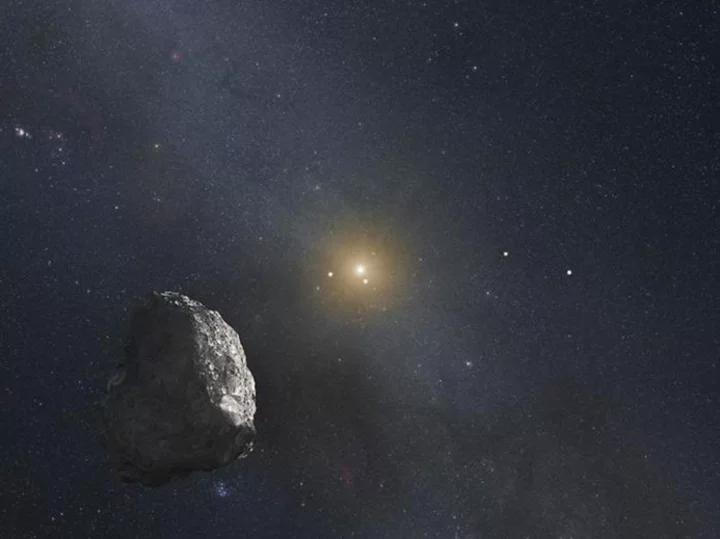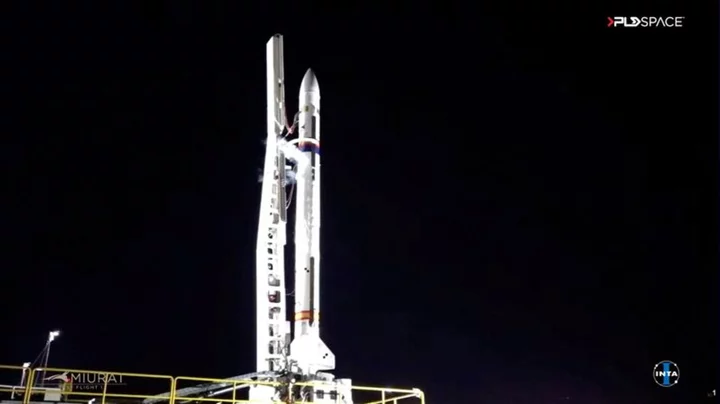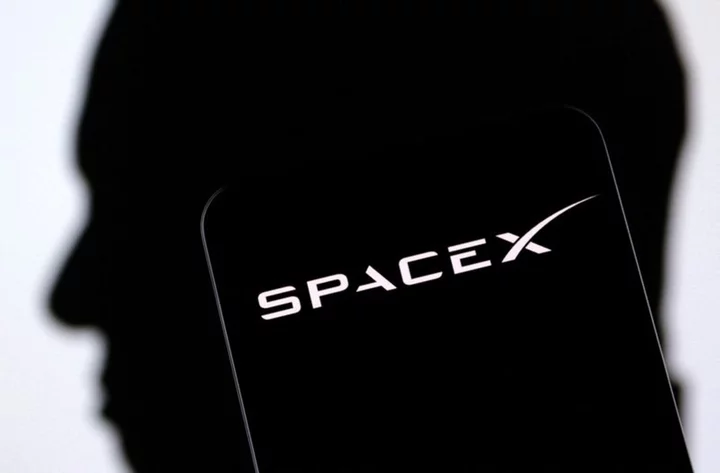
‘Planet Nine’ hidden world at the edge of our solar system could actually be something else, scientists say
A supposed “planet nine” that lies hidden at the edge of our solar system could actually be something else entirely, according to scientists. The unexplained movement of objects at the edge of our solar system has led some to propose that they are being influenced by another world, hidden in the dark distance of our planetary neighbourhood, that they have referred to as planet nine. Objects at the far reaches of the solar system behave as if they are being pulled around by an object that we cannot see, which is probably another planet, they suggest. But a new study by researchers Harsh Mathur, a professor of physics at Case Western Reserve University, and Katherine Brown, an associate professor of physics at Hamilton College, say that those movements are instead the result of a modified law of gravity. The scientists plotted what would happen if the objects were being governed by a theory known as Modified Newtonian Dynamics or MOND. That suggests that Newton’s usual gravity only works up to a point – that in the outer regions of galaxies, for instance, gravity behaves in unusual ways. They found that the data lined up, and applying the MOND theory to the existing observations seemed to predict them exactly. “The alignment was striking,” said Professor Mathur. They note that the findings do not necessarily rule out planet nine – or another explanation for what is going on. Some researchers have suggested other explanations for what the objects could be, for instance, while others have suggested that the claimed effect is just the result of when the distant objects tend to be observed. “Regardless of the outcome, this work highlights the potential for the outer solar system to serve as a laboratory for testing gravity and studying fundamental problems of physics,” said Professor Brown. The findings are reported in a paper, ‘Modified Newtonian Dynamics as an Alternative to the Planet Nine Hypothesis’, published in The Astronomical Journal. Read More Watch live: Amazon launches first internet satellites aiming to rival Starlink Stargazing in October: A sleeping giant Prada to design Nasa’s next-gen space suits for Artemis astronauts
1970-01-01 08:00

Spain's PLD Space counts down to test rocket launch from Europe
MADRID Spanish startup PLD Space will attempt a test launch of its reusable Miura-1 rocket early on Saturday,
1970-01-01 08:00

China to double the size of its space station as it offers an alternative to NASA-led ISS
China plans to expand its space station to six modules from three in coming years, offering astronauts from other nations an alternative platform for near-Earth missions as the NASA-led International Space Station (ISS) nears the end of its lifespan.
1970-01-01 08:00

SpaceX sued by engineer claiming underpayment of women, minorities
By Daniel Wiessner Elon Musk's SpaceX has been sued by a female former employee who claims the rocket
1970-01-01 08:00

Earth hit by blast of energy from dead star so powerful that scientists can’t explain it
Earth has been hit by a blast from a dead star so energetic that scientists cannot explain it. The burst of gamma rays, originating in a dead star known as a pulsar, is the most high energy of its kind ever seen. It was equivalent about ten trillion times the energy of visible light, or 20 tera-electronvolts. Scientists are unable to explain exactly what kind of a scenario could lead a pulsar to emit such intense energy, and the researchers behind the breakthrough say that it “requires a rethinking of how these natural accelerators work”. Scientists hope that they can find yet more powerful energy blasts from pulsars, with a view to better understanding how they are formed. Pulsars are formed when a star dies, exploding in a supernova and leaving behind a tiny, dead star. They are just 20 kilometres across, and spin extremely fast with a powerful magnetic field. “These dead stars are almost entirely made up of neutrons and are incredibly dense: a teaspoon of their material has a mass of more than five billion tonnes, or about 900 times the mass of the Great Pyramid of Giza,” said Emma de Oña Wilhelmi, a scientist at the High Energy Stereoscopic System observatory in Namibia that detected the blast. As pulsars spin, they throw out beams of electromagnetic radiation, throwing it out like a cosmic lighthouse. That means that someone in one spot – like the Earth – will see the radiation pulses flash in a regular rhythm as they spin past. The radiation is thought to be the result of fast electrons that are produced and thrown out by the the pulsar’s magnetosphere, which is made up of plasma and electromagnetic fields that surround the star and spin with it. Scientists can search the radiation for different energy bands within the electromagnetic spectrum, helping them understand it. When scientists previously did that with the Vela pulsar examined in the new study, they found that it was the brightest everseen in the radio band, and the brightest persistent source in the giga-electronvolts. But the new research found that there is a part of the radiation with even more high energy components. “That is about 200 times more energetic than all radiation ever detected before from this object,” said co-author Christo Venter from the North-West University in South Africa. Scientists don’t know exactly how that could happen. 
“This result challenges our previous knowledge of pulsars and requires a rethinking of how these natural accelerators work,” says Arache Djannati-Atai from the Astroparticle & Cosmology (APC) laboratory in France, who led the research. “The traditional scheme according to which particles are accelerated along magnetic field lines within or slightly outside the magnetosphere cannot sufficiently explain our observations. “Perhaps we are witnessing the acceleration of particles through the so-called magnetic reconnection process beyond the light cylinder, which still somehow preserves the rotational pattern? But even this scenario faces difficulties to explain how such extreme radiation is produced.” An article describing the findings, ‘Discovery of a Radiation Component from the Vela Pulsar Reaching 20 Teraelectronvolts’, is published today in the journal Nature Astronomy. Read More ‘Ring of fire’ solar eclipse this month will be last until 2046 Mystery behind massive star suddenly vanishing decoded New discovery is ‘holy grail’ breakthrough in search for aliens, scientist say ‘Ring of fire’ solar eclipse this month will be last until 2046 Mystery behind massive star suddenly vanishing decoded New discovery is ‘holy grail’ breakthrough in search for aliens, scientist say
1970-01-01 08:00

Prada and Axiom Space collaborate to design NASA's lunar spacesuits
MILAN Italian luxury group Prada and Texas-based startup Axiom Space will collaborate to design NASA's lunar spacesuits for
1970-01-01 08:00

U.S. FAA closes probe of Blue Origin's 2022 rocket mishap, requires engine redesign
By Joey Roulette WASHINGTON (Reuters) -The U.S. Federal Aviation Administration on Wednesday said it has closed a probe into Blue
1970-01-01 08:00

Starfield Shattered Space Story Expansion: Release Date, Known Info
There aren't many public details about Shattered Space. Here's everything we know about the Starfield expansion so far.
1970-01-01 08:00

U.S. astronaut Rubio and two Russian cosmonauts land in Kazakhstan
ALMATY (Reuters) -U.S. astronaut Frank Rubio, who broke the record for the longest continuous space flight by an American, and
1970-01-01 08:00

The Orionid Meteor Shower Will Light Up Skies in October: Here’s How to Catch It
The Orionid meteor shower is visible around the world, and this year it peaks the night of Saturday, October 21.
1970-01-01 08:00

NBA rumors: Pacers asking price for Buddy Hield, Jazz ready to trade, Wade defends Howard
In today's NBA rumors — what the Pacers want for Buddy Hield, how the Jazz are looking to deal, and why Dwyane Wade thinks Dwight Howard was snubbed.
1970-01-01 08:00

Scientists develop simple test to help us find alien life
Scientists have developed a simple test in the search for alien life, they claim. The breakthrough helps the search for the “holy grail” of astrobiology: a reliable test that will determine whether there is or was life on other planets. The discovery uses artificial intelligence to determine with 90 per cent accuracy whether a sample is biological or not. And it could be used on existing samples, researchers say. That might mean, for instance, that we already have gathered the samples that could tell us whether there is life on Mars. Scientists hope that their test could be used on samples already collected by the Mars Curiosity rover’s Sample Analysis at Mars (SAM) instrument. The rover has an instrument on board to analyse those samples, and that data could be used in the test. The findings could also help tell us more about our own planet, revealing the history of mysterious and ancient rocks found on Earth. “The search for extraterrestrial life remains one of the most tantalizing endeavors in modern science,” said lead author Jim Cleaves of the Earth and Planets Laboratory, Carnegie Institution for Science, Washington, DC. “The implications of this new research are many, but there are three big takeaways: First, at some deep level, biochemistry differs from abiotic organic chemistry; second, we can look at Mars and ancient Earth samples to tell if they were once alive; and third, it is likely this new method could distinguish alternative biospheres from those of Earth, with significant implications for future astrobiology missions.” The technique does not look for specific molecules or compounds that could be indicative of life, as much previous work has done. Instead, it looks for small differences in the molecular patterns of samples using different kinds of analysis. It was built by giving an artificial intelligent system data about 134 known samples, with information about whether they are biotic or abiotic. To test it, it was then given new samples – including those from living things, remnants of ancient life and other abiotic samples that did not point to life, such as pure chemicals – and identified them with 90 per cent accuracy. The system also started predicting another kind of sample type, dividing the biotic ones into “living” and “fossils”. That means it could tell the difference between a freshly harvested leaf and something else that died long ago, for instance. Scientists hope that with time it could eventually be able to distinguish other hints in the data, such as signs of photosynthesis or cells that have a nucleus. Previous research has struggled because organic molecules tend t degrade over time. But the new method works even when the samples have decayed and changed significantly, the researchers behind it said. “This routine analytical method has the potential to revolutionize the search for extraterrestrial life and deepen our understanding of both the origin and chemistry of the earliest life on Earth,” said Robert Hazen, of the Carnegie Institution for Science, one of the leaders of the research. “It opens the way to using smart sensors on robotic spacecraft, landers and rovers to search for signs of life before the samples return to Earth.” The findings could also help solve mysteries on life. Many ancient rocks on Earth are at the middle of argument over whether they hold the oldest fossil microbes in life, while others say they do not have any life – and researchers are already feeding data about those rocks from Australia, Canada and elsewhere into the tool. “We’re applying our methods right now to address these long-standing questions about the biogenicity of the organic material in these rocks,” Hazen says. A paper describing the work, ‘A robust, agnostic biosignature based on machine learning’, is published in the Proceedings of the National Academy of Sciences. Read More Nasa has gathered a large piece of a distant asteroid. What now? Nasa spots shocking number of galaxies like our own Nasa just delivered a piece of a distant asteroid to Earth Nasa has gathered a large piece of a distant asteroid. What now? Nasa spots shocking number of galaxies like our own Nasa just delivered a piece of a distant asteroid to Earth
1970-01-01 08:00
